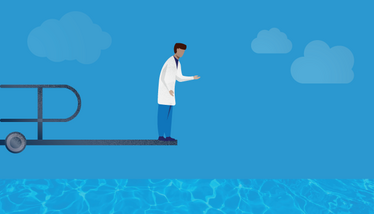Pool Power
Why is the stable pools approach attracting more attention in the cell line development space?
Simon Keen, Brett Verstak | | 4 min read | Technology

At the core of biopharmaceutical production is cell line development (CLD). CLD stands as the foundation upon which the success of biologics is constructed. It is a complex and crucial phase, where many aspects of the scalability, reproducibility, and quality of biotherapeutic production are determined.
The global monoclonal antibody (mAb) market is forecasted to expand significantly by 2030 (1). The specificity and efficacy of mAbs have revolutionized treatment protocols, providing targeted therapy that improves patient outcomes and quality of life. However, the rapid ascent of mAbs has not been without its challenges. The sheer pace of growth has challenged existing CLD frameworks, and the industry now needs new methods that can keep up with demand – without compromising on quality and efficacy.
Obtaining high-yield and stable productivity in the development of mAbs is not always straightforward. Challenges stem from the inherent variability of mAb sequences, the heterogeneity within populations of transformed cells and the need to maintain consistent expression of the therapeutic protein across all production scales. Monoclonal cell substrate for biotherapeutic production must ensure consistency across scales and batches. This means selecting and characterizing single clones that can meet the demands of productivity and product quality in a relevant manufacturing process. Traditional workflows rely on identifying a clone and then optimizing upstream and downstream processes to develop and lock in a manufacturing process. Only then is representative material produced, allowing for formulation, analytical method validation and GLP-toxicology studies to progress. In other words, there is a bottleneck in the race to IND application (2).
The use of stable pools to produce representative material earlier in the development process has been gaining traction as an approach to optimize workflows and can be incorporated into cell line development platforms. Although not clonal, improved vectors, host cell line, and methods can generate stable pools that maintain productivity and the quality of the biologic over time (3). Characterization data obtained from the stable pool material can be used to set a quality target product profile (QTPP).
Next, clonal populations can be derived from the bulk stable pools using high-throughput screening methods to assess productivity and product quality from a large number of clones, selecting those that conform with the QTPP (and thereby match the CQA of the pools), as well as meeting the stringent criteria required from a cell line for further development and conform to ICH guidance.
Having reliable, fast producing stable pools offers several advantages – not least the fact that the pools allow for the generation of purified product at an earlier stage, making it possible to commence multiple non-clinical activities in parallel, such as formulation development and analytical method validation. Reports have demonstrated that materials from cell pools, such as those used in the development of antibodies against SARS-CoV-2, exhibit comparable quality, stability of expression, and product performance to those derived from final selected clones, thereby supporting the use of cell pools for the manufacture of preclinical material and accelerating the time to IND (4).
Recent advances in vector technologies have directly impacted the efficacy of the stable pools approach. CROs are now partnering with innovators in the vector space to enhance their existing cell line to help customers with difficult-to-express proteins. Modern vector systems offer enhanced gene expression stability, which is crucial in the stable pools approach, where the mixed population of cells requires reliable gene expression to maintain consistency in the biologic product.
Improved host cell lines are also having an impact. Here, desirable features, such as reduced glycosylation variability and increased stress resistance, are vital to maintain the integrity and functionality of biologics produced through the stable pools method (5, 6). Incorporation of structured platform processes into CLD has also led to benefits. These platform processes consist of standardized methods that ensure consistent and predictable results, helping streamline development.
To recap, by facilitating earlier material generation and enabling parallel process development, stable pools could significantly shorten the drug development timeline, allowing for a more responsive approach to emerging health challenges. It may also catalyze a shift in regulatory paradigms; ultimately, consistent quality attributes from stable pools could streamline the approval process for new biologics with greater acceptance that stable pool material may be suitable in both GLP toxicology studies and even in a clinical setting (7).
As the industry looks to the future, the continued refinement and adoption of the stable pools approach will play an important role in meeting the growing global demand for biologics and maintaining the momentum of success in the biopharma industry.
- Lu RM, Hwang YC, Liu IJ, Lee CC, Tsai HZ, Li HJ, Wu HC. Development of therapeutic antibodies for the treatment of diseases. J Biomed Sci. 2020 Jan 2;27(1).
- Sifniotis V, Cruz E, Eroglu B, Kayser V. Current Advancements in Addressing Key Challenges of Therapeutic Antibody Design, Manufacture, and Formulation. Antibodies (Basel). 2019 Jun 3;8(2):36.
- Munro TP, Le K, Le H, Zhang L, Stevens J, Soice N, Benchaar SA, Hong RW, Goudar CT. Accelerating patient access to novel biologics using stable pool-derived product for non-clinical studies and single clone-derived product for clinical studies. Biotechnol Prog. 2017 Nov;33(6):1476-1482.
- Broly H, Souquet J, Beck A. Effects of the COVID-19 pandemic: new approaches for accelerated delivery of gene to first-in-human CMC data for recombinant proteins. MAbs. 2023 Jan-Dec;15(1):2220150.
- Li F, Vijayasankaran N, Shen AY, Kiss R, Amanullah A. Cell culture processes for monoclonal antibody production. MAbs. 2010 Sep-Oct;2(5):466-79.
- Goulet DR, Atkins WM. Considerations for the Design of Antibody-Based Therapeutics. J Pharm Sci. 2020 Jan;109(1):74-103. doi: 10.1016/j.xphs.2019.05.031. Epub 2019 Jun 4.
- Joubert S, Stuible M, Lord-Dufour S, Lamoureux L, Vaillancourt F, Perret S, Ouimet M, Pelletier A, Bisson L, Mahimkar R, Pham PL, L Ecuyer-Coelho H, Roy M, Voyer R, Baardsnes J, Sauvageau J, St-Michael F, Robotham A, Kelly J, Acel A, Schrag JD, El Bakkouri M, Durocher Y. A CHO stable pool production platform for rapid clinical development of trimeric SARS-CoV-2 spike subunit vaccine antigens.
Vice President of Cell Line Development at Abzena
Director of Cell Line Development at Abzena


















